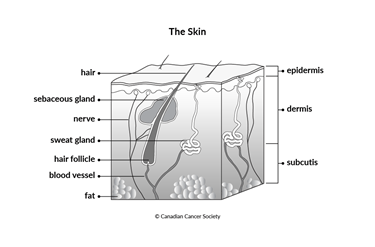The skin
The skin is the body’s largest organ. It covers your entire body and protects you against injury and what can harm you in the environment, such as hot temperatures and germs. The skin is important for many body functions.

Functions of the skin
The skin has many functions. It:
- protects the body from heat, cold, sunlight, injury and infection
- controls body temperature
- stores water and fat
-
prevents the loss of fluid and
electrolytes - removes waste products from the body through sweat
- provides the sense of touch, including temperature, pain and pressure
-
helps make
vitamin D
Layers of the skin
The epidermis and dermis are the 2 main layers of the skin. They lie on top of a third layer called the subcutis.
Epidermis
The epidermis is the top or outer layer of the skin that you can see. It is a thin, tough layer of skin that protects the body, gives skin its colour and makes new skin. The epidermis is made of several different types of cells and has 2 layers.
Squamous cells
Squamous cells are flat cells that make up one of the outer cell layers of the epidermis (called the squamous cell layer).
Squamous cells start from keratinocytes, which are cells that contain a tough, protective protein called keratin. As keratinocytes move toward the surface of the skin, they start to change. The keratinocytes get bigger and flatter and stick together (becoming squamous cells), then eventually die. The dead squamous cells on the surface of the skin are constantly shed from the skin and replaced by new cells.
Basal cells
Basal cells are round cells in the deepest part of the epidermis (called the basal cell layer).
Basal cells continually divide, make new cells and push the older cells toward the surface of the skin. The older basal cells eventually become squamous cells and then mature keratinocytes.
Melanocytes and other cells
Melanocytes are cells found in the deepest part of the epidermis along with
basal cells. They are also found in hair follicles and the retina of the
eye. Melanocytes make melanin, which is the substance that gives skin its
colour and helps protect the body from some of the harmful effects of the
sun and ultraviolet radiation (UVR). When your skin is exposed to UVR from
the sun, the melanocytes make more melanin. This causes the skin to darken
or become tanned. The extra melanin is transferred to other skin cells
(keratinocytes) to help protect the skin and the
The amount of melanin made is also affected by your genes. People with white skin make less melanin and are at a higher risk of sun damage than people with other skin types. People with brown and black skin have more protection from the sun because their melanocytes are more active and make more melanin.
Other types of specialized cells found in the epidermis include:
- Langerhans cells that support the immune system by attaching to and helping destroy foreign substances invading the skin (called antigens)
- Merkel cells that help give the skin its sense of touch
Dermis
The dermis is the thickest layer of skin under the epidermis. Collagen and elastin are proteins in the dermis that give skin strength, sturdiness, stretch and flexibility.
The dermis contains many structures including:
- blood vessels that carry nutrients and oxygen to the skin
- lymph vessels that help fight infection
- hair follicles, which are small sacs where hair starts growing
- sweat glands that make sweat to control body temperature
- sebaceous glands that make oil to keep the skin and hair smooth
- nerve endings that help provide the sense of touch
Subcutis
The subcutis is the innermost layer of the skin, under the dermis, and is mainly made up of fat tissue. It helps keep the body warm and protect the internal organs and delicate tissues from injury. The subcutis is also called the hypodermis or subcutaneous tissue.
Your trusted source for accurate cancer information
With support from readers like you, we can continue to provide the highest quality cancer information for over 100 types of cancer.
We’re here to ensure easy access to accurate cancer information for you and the millions of people who visit this website every year. But we can’t do it alone.
Every donation helps fund reliable cancer information, compassionate support services and the most promising research. Please give today because every contribution counts. Thank you.
